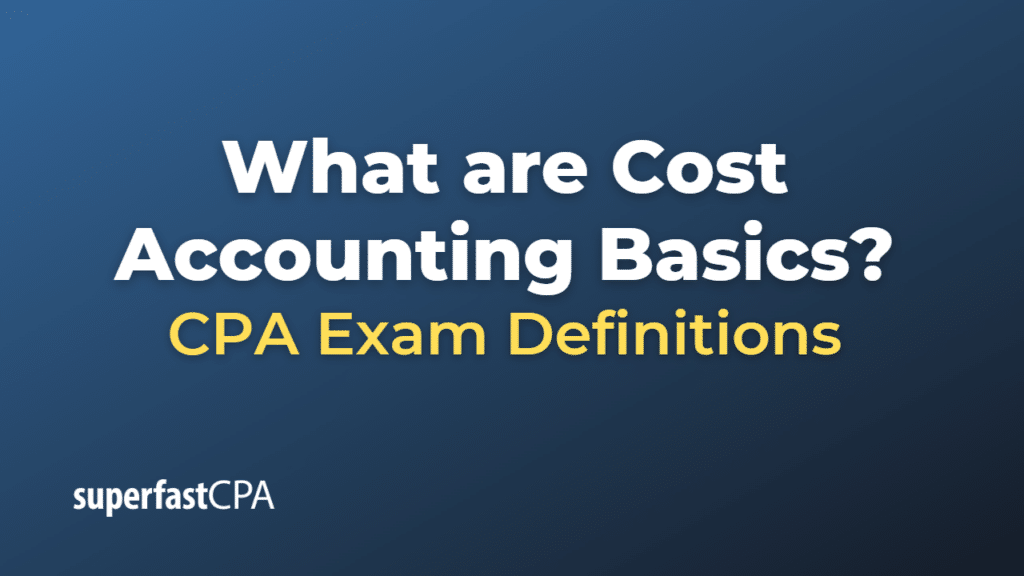Cost Accounting Basics
Cost accounting basics refer to the fundamental concepts, methods, and principles that guide the process of identifying, measuring, and analyzing costs associated with an organization’s production, operations, or projects. Understanding these basics helps organizations manage costs effectively, make informed financial decisions, and improve profitability and efficiency. Here are some key cost accounting basics:
- Cost classification: Costs can be classified in various ways based on different criteria, such as:
- Direct costs vs. indirect costs: Direct costs are directly attributable to a specific product, service, or project (e.g., raw materials, labor), while indirect costs cannot be directly traced to a specific product, service, or project (e.g., rent, utilities, administrative expenses).
- Fixed costs vs. variable costs: Fixed costs remain constant regardless of production levels (e.g., rent, salaries), while variable costs change in proportion to production levels (e.g., raw materials, direct labor).
- Cost allocation: Cost allocation involves assigning indirect costs to different cost centers, departments, or products using appropriate allocation methods, such as direct labor hours, machine hours, or square footage. This process helps determine the total cost of a product or service and supports decision-making, pricing, and performance evaluation.
- Costing methods: Cost accounting uses different costing methods to calculate the cost of products or services, such as:
- Job costing: Used for customized products or services, where costs are accumulated for each individual job or project.
- Process costing: Used for mass-produced, homogeneous products, where costs are accumulated for each process or department and then allocated to the units produced.
- Activity-based costing (ABC): Allocates costs to products or services based on the activities that drive the costs, providing a more accurate representation of the resources consumed.
- Inventory valuation: Cost accounting involves monitoring and managing inventory levels and valuing inventory using appropriate costing methods, such as:
- First-In, First-Out (FIFO): Assumes that the first items purchased or produced are the first ones to be sold.
- Last-In, First-Out (LIFO): Assumes that the most recently purchased or produced items are the first ones to be sold.
- Weighted Average Cost: Calculates the average cost of all items in inventory and assigns this cost to each unit sold.
- Budgeting and forecasting: Cost accounting assists in the preparation of budgets and forecasts by estimating future costs based on historical data, trends, and management input. Comparing actual costs against budgeted figures and providing variance analysis supports decision-making.
- Cost control and reduction: Identifying opportunities for cost reduction and efficiency improvements by analyzing cost data and working with management to implement cost-saving initiatives.
- Financial reporting: Cost accounting prepares periodic cost reports and financial analyses to support management decision-making and financial reporting.
Understanding the cost accounting basics helps organizations manage their costs effectively, make informed decisions, and improve profitability. Cost accountants play a crucial role in implementing these basic principles and ensuring that an organization’s cost management practices are accurate, efficient, and aligned with its strategic objectives.
Example of Cost Accounting Basics
Let’s consider an example of cost accounting basics applied at a small furniture manufacturing company called “CozyHome Furniture.”
CozyHome Furniture produces a variety of custom-made wooden furniture items, such as chairs, tables, and cabinets. To manage its costs effectively and make informed financial decisions, CozyHome Furniture implements various cost accounting activities based on the cost accounting basics:
- Cost classification: CozyHome Furniture classifies its costs as direct and indirect costs. Direct costs include raw materials (e.g., wood, screws, nails) and direct labor (e.g., carpenters, painters). Indirect costs include rent, utilities, and administrative expenses.
- Cost allocation: The company allocates indirect costs to different furniture items using appropriate allocation methods. For instance, rent and utilities are allocated based on the square footage occupied by the production of each furniture item.
- Costing method: CozyHome Furniture uses job costing, as it produces custom-made furniture items. Each job represents a specific order for a customer, and the costs are accumulated and tracked separately for each job.
- Inventory valuation: The company values its inventory of raw materials and finished goods using the First-In, First-Out (FIFO) method. This assumes that the first materials purchased are the first ones used in production and the first finished goods produced are the first ones sold.
- Budgeting and forecasting: CozyHome Furniture prepares annual budgets and quarterly forecasts by estimating future production costs based on historical data, current trends, and input from management. They compare actual costs against budgeted figures and provide variance analysis to support decision-making.
- Cost control and reduction: CozyHome Furniture identifies opportunities for cost reduction by analyzing production processes and working with the operations team to implement cost-saving initiatives, such as negotiating better prices with suppliers or reducing waste during production.
- Financial reporting: The company’s cost accounting team prepares periodic cost reports, such as job cost summaries and gross margin analysis, to support management decision-making and financial reporting.
In this example, CozyHome Furniture applies the cost accounting basics to manage its costs effectively, support decision-making, and maintain profitability. By implementing these basic principles, the company can make informed decisions about resource allocation, pricing, and cost control to maintain its competitiveness in the custom furniture market.













